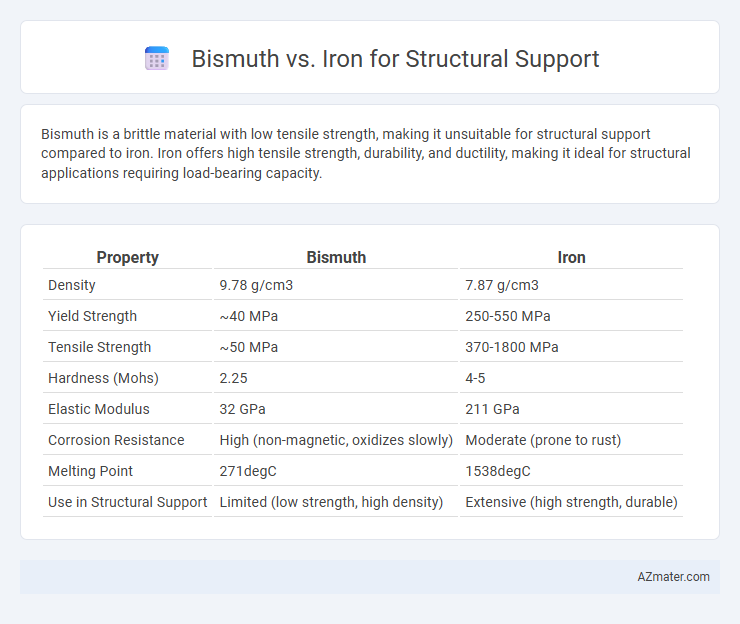Bismuth is a brittle material with low tensile strength, making it unsuitable for structural support compared to iron. Iron offers high tensile strength, durability, and ductility, making it ideal for structural applications requiring load-bearing capacity.
Table of Comparison
| Property | Bismuth | Iron |
|---|---|---|
| Density | 9.78 g/cm3 | 7.87 g/cm3 |
| Yield Strength | ~40 MPa | 250-550 MPa |
| Tensile Strength | ~50 MPa | 370-1800 MPa |
| Hardness (Mohs) | 2.25 | 4-5 |
| Elastic Modulus | 32 GPa | 211 GPa |
| Corrosion Resistance | High (non-magnetic, oxidizes slowly) | Moderate (prone to rust) |
| Melting Point | 271degC | 1538degC |
| Use in Structural Support | Limited (low strength, high density) | Extensive (high strength, durable) |
Introduction to Bismuth and Iron
Bismuth, a brittle metal with low tensile strength and high density, is primarily used in specialized applications rather than structural support due to its poor mechanical properties. Iron, a fundamental element in construction, offers high tensile strength, ductility, and durability, making it ideal for structural frameworks in buildings, bridges, and infrastructure. The stark contrast in mechanical performance and cost efficiency firmly establishes iron as the preferred choice for load-bearing structural applications.
Chemical and Physical Properties Comparison
Bismuth exhibits low tensile strength and high brittleness compared to iron, which possesses superior mechanical strength and ductility, making iron more suitable for structural support. Chemically, iron is prone to oxidation forming rust (Fe2O3), whereas bismuth is highly corrosion-resistant and non-magnetic, but its higher density (9.78 g/cm3 vs. iron's 7.87 g/cm3) and low melting point (271degC versus iron's 1538degC) limit its use in load-bearing applications. Iron's crystalline body-centered cubic (BCC) and face-centered cubic (FCC) structures at different temperatures contribute to its robustness, contrasting with bismuth's rhombohedral crystal lattice that favors brittleness over structural integrity.
Structural Strength and Durability
Iron exhibits significantly higher structural strength compared to bismuth, with a tensile strength typically around 370 MPa versus bismuth's much lower value near 20 MPa. Iron's exceptional durability stems from its resistance to deformation under load and its ability to withstand dynamic stress in construction applications. Conversely, bismuth's brittleness and low mechanical strength limit its use in structural support roles where long-term stability and high load-bearing capacity are critical.
Weight and Density Differences
Bismuth has a density of approximately 9.78 g/cm3, making it significantly denser than iron, which has a density around 7.87 g/cm3. This higher density means bismuth is considerably heavier than iron for the same volume, impacting its suitability for structural support where weight is a critical factor. Iron's lower density combined with its high tensile strength makes it more practical and cost-effective for most structural applications requiring durability and weight efficiency.
Corrosion Resistance and Longevity
Bismuth exhibits poor corrosion resistance and is prone to oxidation, making it unsuitable for long-term structural support compared to iron, which forms a stable oxide layer that protects it from further rusting. Iron alloys, especially stainless steel, offer superior longevity due to their enhanced corrosion resistance and mechanical strength, crucial for structural applications. In contrast, bismuth's brittle nature and low mechanical durability limit its viability for structural uses, emphasizing iron's dominance in corrosion resistance and longevity.
Cost and Material Availability
Bismuth is significantly more expensive and less abundant compared to iron, making iron a more cost-effective choice for structural support applications. Iron's widespread availability and lower production costs contribute to its dominance in construction and infrastructure projects. The limited global reserves of bismuth restrict its use primarily to specialized applications rather than large-scale structural frameworks.
Workability and Fabrication Methods
Bismuth exhibits low ductility and limited malleability, making it challenging for structural support applications that require extensive shaping or welding. Iron offers superior workability due to its high tensile strength and ease of fabrication through rolling, forging, and welding techniques commonly used in construction and manufacturing. Fabrication methods for iron include casting, machining, and heat treatment, enabling tailored mechanical properties for robust structural support, unlike bismuth which lacks scalability for such processes.
Environmental Impact and Sustainability
Bismuth offers a low-toxicity alternative to lead in structural applications, but its higher cost and lower strength compared to iron limit its widespread use. Iron, especially when sourced from recycled scrap, provides robust structural support with a well-established recycling infrastructure, reducing its environmental footprint. Sustainable choice favors iron for large-scale structural projects due to its durability, abundance, and efficient recyclability, while bismuth is more niche, valued for specialized, less load-intensive applications.
Common Structural Applications
Iron outperforms bismuth in common structural applications due to its superior tensile strength, durability, and load-bearing capacity. Iron alloys, such as steel, are widely used in construction for beams, columns, and bridges, providing essential support where high strength and resilience are critical. Bismuth's low mechanical strength and brittleness limit its use in structural support, confining it to niche applications like non-toxic ballast or specialized low-stress components.
Final Verdict: Choosing Between Bismuth and Iron
Iron is significantly stronger and more durable than bismuth, making it the preferred choice for structural support in construction and industrial applications. While bismuth offers corrosion resistance and low toxicity, its brittleness and lower tensile strength limit its suitability for load-bearing frameworks. For final verdict, iron stands out as the optimal material for reliable, long-lasting structural support due to its superior mechanical properties.

Infographic: Bismuth vs Iron for Structural support
 azmater.com
azmater.com